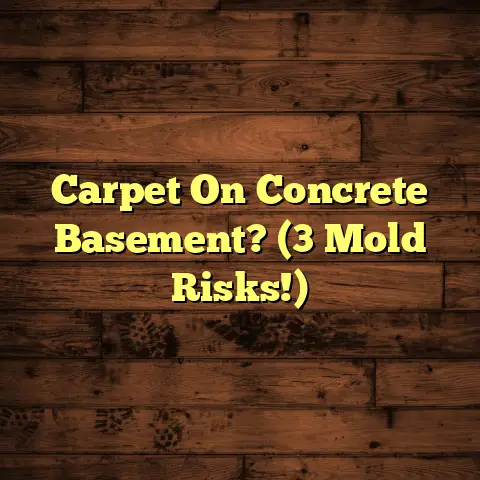Laminate Underlayment: Is It Needed? (3 Reasons!)
Here’s the article:
Laminate Underlayment: Is It Needed?
(3 Reasons!) – A Contractor’s Perspective
I’m Mike, a flooring contractor with over 15 years under my belt, and I’ve seen it all when it comes to flooring.
Today, let’s talk about something near and dear to my heart: laminate underlayment.
Specifically, we’re going to focus on why it’s so important here in the Pacific Northwest.
Think of all the rain we get – it definitely impacts our homes!
Laminate flooring is super popular, and for good reason.
It’s affordable, durable, and looks great.
But is underlayment just an upsell, or is it actually needed?
I’m here to tell you, from my years of experience dealing with PNW homes, it’s almost always a must.
Let’s dive into why!
Understanding Laminate Flooring and Underlayment
Definition of Laminate Flooring
So, what is laminate flooring, exactly?
It’s basically a multi-layer synthetic flooring product.
It’s fused together using a lamination process.
Typically, you’ve got a core layer made of high-density fiberboard (HDF) or medium-density fiberboard (MDF).
Then, there’s a decorative layer that looks like wood, stone, or tile.
Finally, a clear wear layer protects everything.
Unlike hardwood, which is solid wood, laminate is a composite.
This makes it more resistant to scratches and dents.
It’s also generally cheaper and easier to install.
That’s why it’s a go-to for many homeowners.
But remember, it’s not waterproof like some vinyl options.
What is Laminate Underlayment?
Think of underlayment as a cushion between your laminate floor and the subfloor.
It’s a thin layer of material, usually foam, cork, or rubber.
It’s rolled out before you install the laminate planks.
The purpose?
It’s to provide a smooth, even surface, and also to offer various benefits we’ll discuss later.
There are different types of underlayment, each with its own pros and cons.
-
Foam underlayment: This is the most common and affordable option. It provides basic cushioning and sound absorption.
-
Cork underlayment: A natural and eco-friendly choice. It offers excellent sound and thermal insulation.
-
Rubber underlayment: Provides superior sound absorption and is often used in multi-story buildings.
-
Combination underlayment: Some underlayments come with a built-in moisture barrier, which is crucial in our damp climate.
Importance of Underlayment
Why bother with underlayment at all?
Well, it’s not just about making the floor feel softer.
Underlayment plays several key roles:
-
Sound Absorption: Reduces noise from footsteps and impact.
-
Moisture Protection: Prevents moisture from the subfloor from damaging the laminate.
-
Thermal Insulation: Helps to keep the floor warmer.
-
Subfloor Leveling: Provides a more even surface for the laminate.
-
Extending Flooring Life: By minimizing stress on the planks.
Without it, you risk a noisy, uncomfortable, and potentially damaged floor.
And trust me, replacing a whole floor is way more expensive than investing in decent underlayment!
Reason 1 – Moisture Protection
Understanding Moisture and Its Impact
Okay, let’s get real about moisture.
It’s the bane of any flooring contractor’s existence, especially here in the Pacific Northwest.
Moisture from the subfloor can wreak havoc on laminate flooring.
It can lead to:
-
Warping: The planks start to bend and lose their shape.
-
Buckling: The floor lifts up in certain areas.
-
Mold Growth: A serious health hazard, especially for those with allergies.
-
Delamination: The layers of the laminate start to separate.
Even if your subfloor looks dry, moisture can still seep up over time.
Concrete slabs, in particular, are notorious for this.
They can hold moisture for years!
Regional Moisture Concerns
Living in the Pacific Northwest, we’re practically swimming in moisture half the year.
Our high humidity and frequent rainfall mean that homes are constantly exposed to moisture.
Basements are particularly vulnerable.
Even with proper ventilation, they can be damp and prone to moisture issues.
Crawl spaces are another problem area.
If they’re not properly sealed, moisture can easily seep into the subfloor.
Slab foundations can also be problematic, especially if they weren’t properly sealed during construction.
According to the National Weather Service, Seattle averages 38 inches of rainfall per year.
That’s significantly higher than the national average of around 30 inches.
This excess moisture penetrates into the ground and affects the subfloors.
I’ve seen countless homes where laminate flooring has been destroyed by moisture damage.
And it’s almost always preventable with the right underlayment.
How Underlayment Provides Protection
So, how does underlayment actually protect against moisture?
Well, certain types of underlayment act as a moisture barrier.
They prevent moisture from the subfloor from reaching the laminate planks.
These underlayments are typically made with a layer of polyethylene film or other waterproof material.
They’re designed to block moisture and prevent it from wicking up into the flooring.
Look for underlayment with a high Moisture Vapor Transmission Rate (MVTR).
This measures how much moisture can pass through the material.
The lower the MVTR, the better the moisture protection.
For example, a good quality underlayment should have an MVTR of less than 1.0 perm.
Also, make sure to properly seal the seams of the underlayment with moisture-resistant tape.
This will create a continuous barrier and prevent moisture from seeping through the cracks.
Case Studies and Examples
I remember one case in particular.
It was a home in Portland, Oregon, with a basement that had been converted into a living space.
The homeowner had installed laminate flooring without underlayment, thinking it would be fine.
Big mistake!
Within a year, the flooring started to warp and buckle.
When I pulled up the laminate, I found mold growing underneath.
The subfloor was damp to the touch.
We ended up having to remove the entire floor, treat the mold, and install a new floor with proper moisture-resistant underlayment.
It was a costly mistake that could have been avoided with a simple investment in underlayment.
Another example is from a client in Seattle, WA.
She had a slab foundation and noticed a musty smell in her living room.
Upon inspection, the laminate flooring was showing signs of warping near the edges.
I recommended a laminate flooring with pre-attached underlayment with a high MVTR rating.
After installation, the musty smell disappeared, and the flooring remained stable.
These are just a couple of examples of how moisture can damage laminate flooring and how underlayment can prevent it.
Reason 2 – Sound Absorption
Importance of Sound Control
Let’s talk about noise.
Nobody likes a noisy floor, especially in multi-story homes or apartments.
Laminate flooring, while beautiful, can sometimes amplify sound.
Footsteps, dropped objects, and even pets walking around can create a lot of noise.
This can be a real problem if you have neighbors living below you or if you’re trying to create a peaceful environment in your home.
Sound transmission is a big concern in urban areas where homes are often close together.
Regional Noise Concerns
Here in the Pacific Northwest, we have a mix of urban and suburban living.
In cities like Seattle and Portland, apartments and condominiums are common.
This means that soundproofing is essential for maintaining peace and quiet.
Even in suburban areas, homes are often built close together, and noise from neighbors can be a nuisance.
Think about the sounds of traffic, construction, or even just kids playing outside.
These sounds can be amplified by laminate flooring and create a noisy environment.
I’ve worked on projects where homeowners were constantly complaining about noise from their neighbors or from their own families walking around upstairs.
In these cases, underlayment can make a huge difference.
Role of Underlayment in Sound Reduction
Underlayment can significantly reduce both impact noise and airborne sound.
-
Impact noise is the sound created when something hits the floor, like footsteps or dropped objects.
-
Airborne sound is sound that travels through the air, like voices or music.
Different types of underlayment offer different levels of sound reduction.
Cork and rubber underlayment are particularly effective at absorbing sound.
They have a dense, resilient structure that dampens vibrations and reduces noise transmission.
Look for underlayment with a high Sound Transmission Class (STC) and Impact Insulation Class (IIC) rating.
These ratings measure how well the underlayment reduces airborne and impact sound, respectively.
A good quality underlayment should have an STC and IIC rating of at least 50.
For even better soundproofing, consider using a thicker underlayment or combining it with other soundproofing materials, like soundproof drywall or insulation.
Real-World Applications
I once worked on a condo project in downtown Seattle where soundproofing was a major concern.
The building had thin walls and floors, and residents were constantly complaining about noise from their neighbors.
We installed a laminate flooring with a high-density rubber underlayment.
The results were amazing!
Residents reported a significant reduction in noise levels, and the building became a much more peaceful place to live.
Another example is a client in Vancouver, WA.
He had a home office on the second floor and was constantly disturbed by noise from his kids playing downstairs.
We installed a cork underlayment beneath the laminate flooring in his office.
He noticed a dramatic improvement in soundproofing.
He was finally able to concentrate on his work without being distracted by noise.
These are just a couple of examples of how underlayment can make a real difference in soundproofing your home.
Reason 3 – Comfort and Thermal Insulation
Comfort Underfoot
Let’s face it: laminate flooring can sometimes feel a little cold and hard underfoot.
This is especially true in the winter months when temperatures drop.
Underlayment can add a layer of cushioning and warmth, making the floor more comfortable to walk on.
It can also help to reduce fatigue if you spend a lot of time standing on the floor.
Think about spending hours in the kitchen cooking or working on a project in your workshop.
A little extra cushioning can make a big difference in your overall comfort.
Thermal Insulation Benefits
Underlayment also provides thermal insulation.
It helps to keep the floor warmer in the winter and cooler in the summer.
This can reduce your energy bills by minimizing heat loss through the floor.
In regions with extreme temperature variations, like the Pacific Northwest, thermal insulation is especially important.
It can help to maintain a consistent temperature in your home and make it more comfortable year-round.
Cork underlayment is particularly effective at providing thermal insulation.
It has a natural insulating property that helps to trap heat and keep the floor warm.
Regional Climate Influence
The Pacific Northwest is known for its mild, but often damp climate.
We experience a wide range of temperatures throughout the year, from freezing winters to warm summers.
This means that thermal comfort is a big concern for homeowners in our region.
A well-insulated floor can help to reduce drafts and keep your home warm in the winter.
It can also help to keep your home cool in the summer by preventing heat from rising through the floor.
This can save you money on your energy bills and make your home more comfortable year-round.
User Experiences
I’ve had many clients tell me that they noticed a significant difference in comfort levels after installing underlayment beneath their laminate flooring.
One client in Bend, Oregon, told me that her floors used to feel freezing cold in the winter.
After we installed underlayment, she said that her floors were noticeably warmer and more comfortable to walk on.
Another client in Spokane, Washington, told me that her floors used to feel hard and unforgiving.
After we installed underlayment, she said that her floors felt much softer and more comfortable to stand on for long periods of time.
These are just a couple of examples of how underlayment can improve the comfort and thermal insulation of your laminate flooring.
Conclusion
So, is laminate underlayment needed?
In my professional opinion, especially here in the Pacific Northwest, the answer is a resounding yes.
It’s not just an optional add-on; it’s an essential component for achieving a durable, comfortable, and long-lasting flooring solution.
We’ve discussed three key reasons why:
-
Moisture Protection: Prevents warping, buckling, and mold growth in our damp climate.
-
Sound Absorption: Reduces noise transmission in multi-story homes and urban areas.
-
Comfort and Thermal Insulation: Makes the floor more comfortable to walk on and helps to regulate temperature.
When deciding on your flooring project, take these factors into consideration.
Don’t skimp on the underlayment.
It’s an investment that will pay off in the long run by protecting your flooring, improving your comfort, and enhancing the value of your home.
Remember, a little extra investment upfront can save you a lot of headaches (and money) down the road!
Happy flooring!





